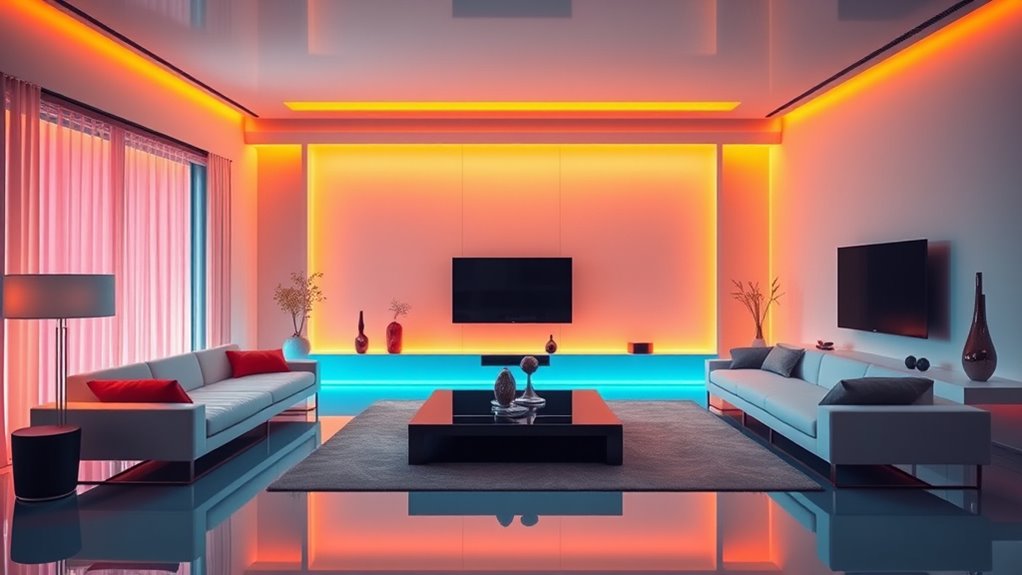Smart lighting systems combine LED technology with AI to help you craft dynamic, personalized ambiance effortlessly. You can control lights via voice or app, adjusting brightness, color, and schedules to match your mood or routine. Motion sensors and automation guarantee energy efficiency while enhancing comfort. These intelligent setups transform your space into a responsive environment that adapts to your lifestyle. Keep exploring to discover how these features can elevate your home experience even further.
Key Takeaways
- Integrate AI algorithms with LED lighting to automatically adjust color, brightness, and scenes for dynamic ambiance.
- Use voice control and automation to create personalized lighting moods for different activities or times of day.
- Employ motion sensors and schedules to enhance energy efficiency while maintaining a responsive, ambient environment.
- Customize lighting scenes and transitions via smartphone apps for seamless, mood-enhancing experiences.
- Leverage AI learning to adapt lighting settings based on user habits, enhancing comfort and ambiance over time.

Have you ever wondered how your home lighting can become more efficient and customizable? Smart lighting systems make this possible by integrating advanced technology that adapts to your lifestyle. With voice control, you can manage your lights effortlessly, simply speaking commands to turn them on or off, adjust brightness, or change colors. This hands-free approach not only provides convenience but also enhances your overall experience. Imagine walking into a room and saying, “Dim the lights,” or “Set the living room to blue,” and having it happen instantly. Voice control simplifies daily routines, reduces the need for physical switches, and creates a seamless, modern environment.
Beyond convenience, smart lighting considerably boosts energy efficiency. Traditional bulbs often waste power or are left on when not needed, but smart systems optimize energy usage by scheduling lights to turn off when rooms are unoccupied or adjusting brightness based on the time of day. Some systems even learn your habits, automatically dim lights during movie nights or brighten them for reading, reducing unnecessary energy consumption. This not only lowers your electricity bills but also benefits the environment by decreasing your carbon footprint. Plus, smart LED bulbs are inherently energy-efficient, consuming less power than traditional incandescent bulbs while providing the same or better quality of light.
Configuring your smart lighting system is straightforward. Many devices connect via Wi-Fi or Zigbee, allowing you to control them through a smartphone app or voice assistants like Alexa, Google Assistant, or Siri. You can create customized lighting scenes for different moods or activities—whether it’s a romantic dinner, a cozy movie night, or energizing morning routines. These scenes can be activated with a simple voice command or scheduled to change automatically, adding a layer of personalization you didn’t have before. The ability to fine-tune your lighting helps establish the perfect ambiance for every moment, all while being mindful of energy consumption.
Moreover, smart lighting systems often come with features like motion sensors, which turn lights on when you enter a room and off when you leave. This further enhances energy efficiency by ensuring lights aren’t left on unnecessarily. You can also set timers or geofencing features that adjust lighting based on your location or daily schedule. All these options give you complete control over your home’s lighting environment, making it more comfortable, sustainable, and aligned with your preferences. In essence, smart lighting transforms your space into a dynamic, responsive environment that adapts to your needs and promotes energy-conscious living.
Frequently Asked Questions
How Do Smart Lighting Systems Impact Energy Consumption?
Smart lighting systems boost your energy efficiency by adjusting brightness and color based on your needs, reducing unnecessary power usage. You’ll notice a lower energy consumption, which positively impacts the environment by decreasing your carbon footprint. With adaptive features like motion sensors and AI control, these systems guarantee lights aren’t left on when not needed, making your home more eco-friendly and cost-effective while maintaining a comfortable, dynamic ambiance.
Can Smart Lighting Integrate With Existing Home Automation Systems?
Integrating smart lighting with your existing home automation is like fitting a puzzle piece perfectly. You can easily connect your lights through voice control, making it simple to adjust brightness and color. Plus, mood customization becomes effortless, allowing you to set scenes for relaxation or entertainment. Most systems are compatible with popular platforms, so you won’t need to overhaul everything—just enhance what you already have for a smarter, more personalized home.
What Are the Privacy Concerns With Ai-Enabled Lighting?
You’re right to be concerned about privacy with AI-enabled lighting. These systems collect data on your habits and preferences, raising issues around data security and user privacy. If not properly protected, this data could be accessed or misused. To stay safe, verify your smart lighting provider uses strong encryption and transparent privacy policies. Regularly update your system and review privacy settings to keep your personal information secure.
How Difficult Is Installing a Smart Lighting System?
Installing a smart lighting system is like assembling a complex puzzle; it can range from simple to challenging. If you’re comfortable with manual installation, you might handle basic setups easily. However, for a seamless experience, especially with advanced features, you may prefer professional assistance. They ensure everything connects correctly, saving you time and frustration. Overall, the difficulty depends on your technical skills and the system’s complexity.
Are There Health Considerations With LED and AI Lighting?
You should be aware that LED and AI lighting can impact your health, especially through blue light exposure, which may disrupt your circadian rhythms. Using bright, blue-rich lights late at night can interfere with sleep patterns, so it’s wise to adjust settings or use warmer tones during evening hours. Properly managing your lighting helps protect your sleep quality and overall well-being while still enjoying the benefits of smart lighting.
Conclusion
By embracing smart lighting systems, you can effortlessly create the perfect ambiance, saving energy and enhancing your space. Did you know that AI-powered lighting can reduce energy consumption by up to 40%? This not only benefits your wallet but also helps the environment. With such innovative technology at your fingertips, you have the power to transform any room into a personalized, dynamic space that adapts to your mood and needs—making every moment brighter and smarter.









